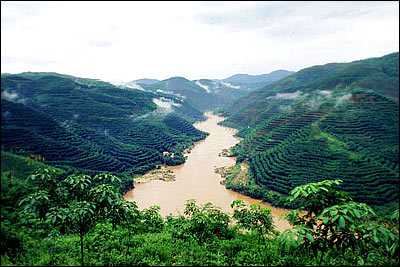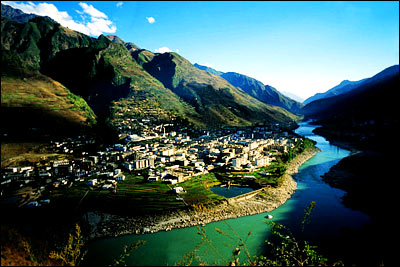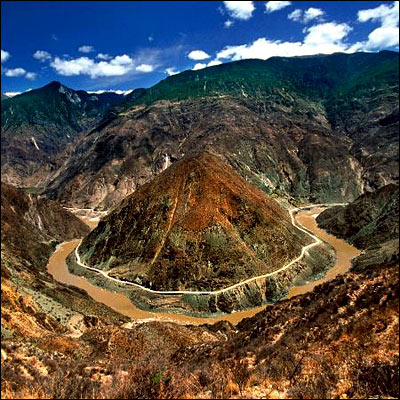| Tools: Save | Print | E-mail | Most Read |
| Three Parallel Rivers Region Under Ecological Threat |
| Adjust font size: |
The Three Parallel Rivers Region of southwest China's Yunnan Province was inscribed on the World Heritage List as a natural property at the 27th session of the World Heritage Committee (WHC) of the United Nations Educational, Scientific and Cultural Organization (UNESCO) held on July 2, 2003. However, at the 30th session held in Vilnius, Lithuania from July 8 to 16 this year, the region was listed one of the key projects under WHC's monitoring due to its worsening environment, China Youth Daily reported on July 18. A report, submitted by experts from the WHC and the World Conservation Union (IUCN), pointed out that the main threats the region is facing include planned hydroelectric development, mining exploration, dam construction and tourism development. Hydroelectric development Located in the mountains of Yunnan Province, the Sanjiang -- the Jinsha, Nujiang and Lancang rivers -- originate from the Qinghai-Tibet Plateau, and run almost parallel to one another north to south for some 170 kilometers, shouldering a total land area of approximately 1.7 million hectares.
There are 15 protected areas in the region: five nature reserves and 10 scenic areas. The in-land areas include Gaoligong Mountain Area (514,022 hectares), Baima-Meili Snow Mountain (349,019 hectares), Laowo Mountain Area (49,161 hectares), Laojun Mountain Area (131,427 hectares), Yunling Mountain Area (89,787 hectares), Red Mountain Area (364,687 hectares) and Haba Mountain Area (200,315 hectares). Experts say that the ecology in this region is so fragile that it would be extremely difficult to repair any damage. Since its inclusion on the World Heritage List in 2003, the region has been placed under WHC monitoring no less than three times. This year's conference demanded that additional materials be submitted by the Chinese government for further examination and approval at next year's conference to ascertain if the Sanjiang region should be listed as an endangered world heritage site. From April 5 to 14, the WCH and IUCN sent a group of experts to Yunnan Province to evaluate the impact of planned development on the local environment. Their report was based on findings during this trip. One of the conclusions the experts drew was that the re-demarcation of boundaries would reduce land area by 20 percent, thereby affecting the region's natural properties. Responding to the resolutions of the 29th WHC Conference, the Chinese government submitted a report on the site's dam construction plans on January 25. According to the report, China only planned to develop hydroelectricity in neighboring areas and not within the region's protected zones. It planned to build nine dams in the lower reaches of the Jinsha River (the original figure was 11, two of which were cancelled considering its impact on local environment); six on the Lancang River (11 originally); and three on the Nujiang River. None of the projects has been put into operation yet since they must go through environmental impact evaluations before they are approved by the central government. WHC experts pointed out that hydroelectric exploration activities would certainly have a huge impact on the Nujiang River. Once dam construction is started, it would alter the river's aesthetic value since the naturally flowing river would become a series of reservoirs. Experts have taken note of the fact that local governments have adopted a series of measures to protect the heritage site such as shutting down a mine in Bingzhongluo area. However, they still can't confirm the possible threats or indirect impact on the environment until the final evaluation report is released. Items under review include migration activities of people in flood-prone areas; road reconstruction and rerouting; habitat and ecological changes following the migration of fish and other species; ecological changes brought about by hydraulic changes; and the possible impact of local earthquakes. Re-demarcation of boundaries The visiting experts were shown a comparison map of the current heritage site before and after planned re-demarcation. According to the map, seven of the eight areas in the site would be adjusted. "The adjustment is still being discussed and has yet to be approved," local officials said.
According to the WHC report, when the region was first made a World Heritage site, IUCN had noticed it included important core areas of high ecological value and their boundaries were clearly marked. The experts pointed out that cutting through the Gaoligong Mountain National Nature Reserve was the most serious. The Gaoligong Mountain stretches along the China-Myanmar border and is an important ecological corridor with consistent natural landscapes. The adjustments would make the nature reserve shrink back along the border, separate the north Gaoligong Mountain from the south nature reserve and the west nature reserve inside the Myanmar territory, and break up the habitats of wild animals. The other planned change proposes to shrink the Red Mountain Area and revise boundaries in the Yunling Mountain Area, both protected sites. Further, the expert panel questioned the new inclusion of two mountain areas into the heritage site, namely, the Gaoligong Mountain Area at Nantengchong and the Cangshan Mountain in Dali City, as the two have already been inhabited and exploited by man. More investigations were called for to determine if the two areas were Category I or II protected areas under the rules of the World Conservation Union (WCU). The reason for the boundary revision was to locate the mine and dam outside of the current protected area. Large-scale copper and zinc mining will be launched soon and the related planning and environmental impact assessments are underway. Despite local officials' assurances that mining would be carried out in accordance with world heritage protection and state laws, the expert panel held that this would not be possible in practice. The WHC therefore demanded that the Chinese government submit another report before January 1, 2007 for examination at the next WHC session. The report should clarify the boundary revision, include a geological map to illustrate local mining information, and justify that the final dam to be constructed conforms to world heritage protection criteria. Moreover, the report should explain its impact on the Sanjiang region's eco-integrity. China's assurances and Sanjiang's future Because there is still much to be clarified, including the result of environmental impact assessments and final plans for the dam to be built on Nujiang River, it is difficult to determine the impact that hydropower facility development will have on the Sanjiang region.
The Three Parallel Rivers have captured the world's attention because of its incomparable value, said Wang Fengwu, vice director of urban construction under the Ministry of Construction and panel member to the 30th WHC Session. He added that any large project near or on the rivers would possibly have a huge impact on the region's ecology, whether directly or indirectly. Wang said that China has very strict procedures for large projects. Further, in a statement from the Chinese delegation submitted to the WHC at the last session, China affirmed that it would not approve large projects on the site or nearby regions, and that local governments would have to abide by that decision. (China.org.cn by Guo Xiaohong and Li Jingrong, July 26, 2006) |
| Tools: Save | Print | E-mail | Most Read |
 |
| Related Stories |
| Product Directory China Search |
Country Search Hot Buys |


